Drying foods
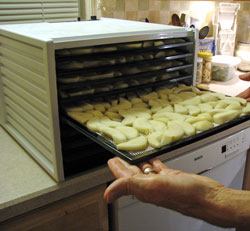 ©Janet Allen Dehydrator with pear slices
©Janet Allen Dehydrator with pear slicesWe've been very pleased with our Excalibur Dehydrator. We bought one of the higher-end products with a timer and temperature control. We also bought the sheets on which you can dry applesauce or other soupy foods.
We've found almost everything we've tried has been delicious. Except for our sour cherries, we haven't dehydrated anything from our own garden, just things we've gotten from u-pick places or from the Regional Market.
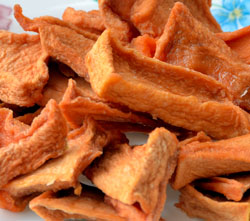 ©Janet Allen
©Janet Allen Dried canteloupe
My favorite is cantalope even though for some reason they're not considered good candidates for drying. (We've purchased cantalopes for this since we don't grow them.)
The first time we tried this, some of the melon became moldy after a month in the glass jars; it's hard to thoroughly dry something as moist as cantaloupe. So now, we don't bother totally drying them; we just freeze them after they're mostly dried. I like the slightly moister texture, and we don't have to worry about mold.
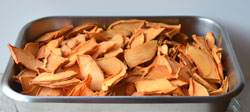 ©Janet Allen
©Janet Allen Six large cantaloupes fit into the space of a 13x9 pan!
So why bother drying them at all? They take up a LOT less space (as well as being extra delicious when they're dried).
As the photo shows, six melons easily fit into a 13x9 pan, and so they take up very little freezer space when they're put into bags.
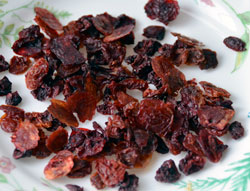 ©Janet Allen
©Janet Allen Drying is a convenient way to preserve our crop of sour cherries
The advantages are that they purportedly maintain their nutritional assets, and the dried products take very little storage space.
The disadvantage is that it does take electricity. Of course, solar drying is possible, but it's not as feasible in Central New York as it might be other sunnier, drier places.
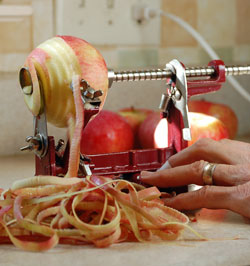 ©Janet Allen Apple rings
©Janet Allen Apple ringsWe dry a lot of apples that we pick at local orchards, preferably the organic orchard when they have apples available.
This inexpensive device actually works! It quickly turns apples into a spiral, which can then be cut into uniform rings perfect for drying.
The cores and peels can be used to make applesauce afterward, and even that can be dried into delicious fruit leather.
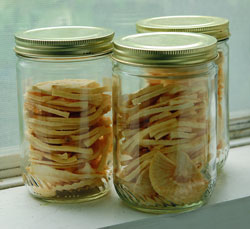 ©Janet AllenJars of dried apples
©Janet AllenJars of dried apples The finished product: jars and jars of delicious dried apples that will last all year (if they don't get eaten first!) Our grandsons love them!
We've also successfully dried pears, tomatoes, and sweet peppers. The pears are delicious, but are quite a bit more work to slice up. Tomatoes are so easy to freeze and take so relatively long to dry that we've been just popping them in the freezer. And if we could find organic red sweet peppers, we'd do some more batches of them just for snacking.
